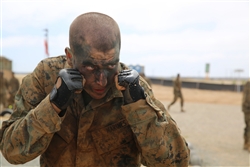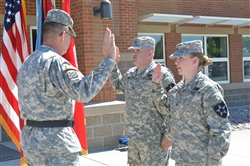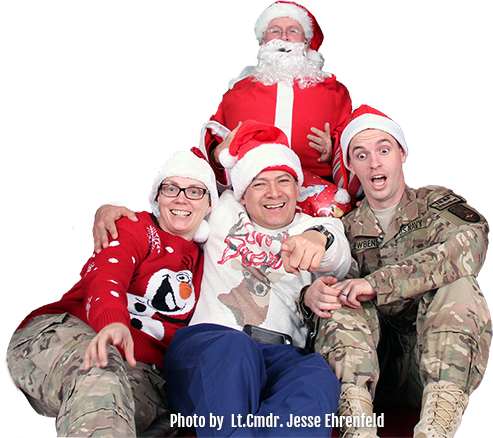Meet Your Military
- Details
- Hits: 2342
 PHOTO: Air Force Senior Airman Lorenza Kates, left, and Senior Airman Victoria Hill, 455th Expeditionary Communications Squadron mail clerks, deliver mail at Bagram Air Field, Afghanistan, June 26, 2014.BAGRAM AIR FIELD, Afghanistan – The 455th Expeditionary Communications Squadron’s mail clerks work daily to boost morale by delivering packages, online orders and letters to the airmen deployed here. Kates and Hill are responsible for handling mail for airmen in the 455th Air Expeditionary Wing. The duo handles thousands of packages and letters each month. U.S. Air Force photo by Staff Sgt. Evelyn Chavez “My favorite part of the job is seeing people’s faces light up when they get mail,” said Air Force Senior Airman Victoria Hill, a 455th ECS mail clerk deployed from Whiteman Air Force Base, Missouri.
PHOTO: Air Force Senior Airman Lorenza Kates, left, and Senior Airman Victoria Hill, 455th Expeditionary Communications Squadron mail clerks, deliver mail at Bagram Air Field, Afghanistan, June 26, 2014.BAGRAM AIR FIELD, Afghanistan – The 455th Expeditionary Communications Squadron’s mail clerks work daily to boost morale by delivering packages, online orders and letters to the airmen deployed here. Kates and Hill are responsible for handling mail for airmen in the 455th Air Expeditionary Wing. The duo handles thousands of packages and letters each month. U.S. Air Force photo by Staff Sgt. Evelyn Chavez “My favorite part of the job is seeing people’s faces light up when they get mail,” said Air Force Senior Airman Victoria Hill, a 455th ECS mail clerk deployed from Whiteman Air Force Base, Missouri.
She hails from Blanchard, Louisiana. Hill is one of two mail clerks responsible for delivering mail to airmen assigned to the wing. Although some of their normal duties at home station involves records and data management, here they ensure timely mail delivery every day. Early in the morning Hill and her comrade, Air Force Senior Airman Lorenza Kates, start their day by coordinating transportation to pick up the mail tri-walls -- pallet-sized boxes -- from a centralized mail location. “I report to work by 6 a.m. then pick up our forklift to lift tri-wall boxes,” said Kates, who is deployed from Davis Monthan Air Force Base, Arizona, and a native of Dublin, Georgia. “Then we make calls to figure out how many pallets we received for the day before we make our way to pick the mail up.”
After picking up mail and taking it back to their office, Kates and Hill unload the pallets for sorting. While one of mail clerks moves the pallets with a forklift, the other arranges them neatly into rows. They sort an average of 77 pallets of mail each week that amounts to approximately 38,500 pounds. “The most difficult part of the job is constantly being on the go,” Hill said. “It is heavy physical labor; we run around loading and unloading. But, I really enjoy it.” Once the packages are sorted, which takes about three hours depending on the number of tri-walls on a given day, Kates and Hill load their truck for mail delivery to mission essential organizations. According to Hill, mission essential units are those unable to leave their work area during the day to pick up mail.
Read more: Meet Your Military: Airmen Deliver Morale-boosting Mail
- Details
- Hits: 2353
 PHOTO: Marine Corps Pvt. Alexander D. Klopfenstein stands in a basic warrior stance during the body sparring event of the Crucible at Edson Range, Marine Corps Base Camp Pendleton, Calif., July 1, 2014. U.S. Marine Corps photo by Cpl. Tyler ViglioneMARINE CORPS RECRUIT DEPOT SAN DIEGO, Calif. – For many potential recruits, enlisting in the Marine Corps is as easy as talking to a recruiter. But for some, it takes some willpower. Marine Corps Pvt. Alexander D. Klopfenstein, Platoon 1025, Bravo Company, 1st Recruit Training Battalion, had to put in some grueling work before he could even consider enlisting. Klopfenstein was born in Bakersfield, California, but he moved around a lot during his high school years. Eventually, the family decided to settle down back in Bakersfield, where he became a member of the Bakersfield High School’s swim team until graduating in 2012.
PHOTO: Marine Corps Pvt. Alexander D. Klopfenstein stands in a basic warrior stance during the body sparring event of the Crucible at Edson Range, Marine Corps Base Camp Pendleton, Calif., July 1, 2014. U.S. Marine Corps photo by Cpl. Tyler ViglioneMARINE CORPS RECRUIT DEPOT SAN DIEGO, Calif. – For many potential recruits, enlisting in the Marine Corps is as easy as talking to a recruiter. But for some, it takes some willpower. Marine Corps Pvt. Alexander D. Klopfenstein, Platoon 1025, Bravo Company, 1st Recruit Training Battalion, had to put in some grueling work before he could even consider enlisting. Klopfenstein was born in Bakersfield, California, but he moved around a lot during his high school years. Eventually, the family decided to settle down back in Bakersfield, where he became a member of the Bakersfield High School’s swim team until graduating in 2012.
Klopfenstein said he loved to swim and competed in the 50-, 200- and 500-meter races. It wasn’t until he graduated from high school, he added, that he started dealing with weight problems. “When I was on the swim team, I would be on a very high-caloric diet,” the 20-year-old Marine said. “After the school year was over, I kept eating the way I had been and wasn’t doing enough exercise to burn it all off, which resulted in me gaining a substantial amount of weight.” At the peak of his weight, and standing at 5 feet 11 inches, Klopfenstein weighed about 270 pounds. His dream always had been to pursue a life in the Marine Corps, he said, but he didn’t know if he would be able to serve because of his weight. “When I first went to talk to the recruiter, they told me I was too big to join,” he said. “I knew that I had to lose the weight and get down to the Marine Corps standards because of how bad I wanted it.” Klopfenstein said he began jogging every day and changed his diet to six small, healthy meals in pursuit of his goal. “The only thing that kept me motivated was that I have always wanted to become a Marine, and I wasn’t going to let the opportunity pass by,” he said.
Read more: Meet Your Military: Marine Completes 90-pound Weight Loss
- Details
- Hits: 2598
 PHOTO: Marine Corps Sgt. Lawanda Ruiz, left, instructs Sgt. Bryan Mack, right, and Cpl. Steven Myint, center, during their Marine Corps Martial Arts Program final field exercise at Camp Lemonnier, Djibouti, June 26, 2014. U.S. Air Force photo by Staff Sgt. Leslie KeopkaCAMP LEMONNIER, Djibouti – Street lights shine down on a tent in a turf field as Marines of all ranks gather inside, night after night, to learn crucial skills that could someday save their lives. These Marines not only are learning important martial arts tactics, but also are learning how to be martial arts instructors. “One mind, any weapon,” is the motto for the Marine Corps Martial Arts Program, meaning that a Marine is a weapon, even without carrying one. Marine Corps Sgt. Lawanda Ruiz, administration chief for the Combined Joint Task Force Horn of Africa personnel office here, has dedicated more than 400 hours as an MCMAP instructor trainer, both here and at her home station of Camp Lejeune, North Carolina.
PHOTO: Marine Corps Sgt. Lawanda Ruiz, left, instructs Sgt. Bryan Mack, right, and Cpl. Steven Myint, center, during their Marine Corps Martial Arts Program final field exercise at Camp Lemonnier, Djibouti, June 26, 2014. U.S. Air Force photo by Staff Sgt. Leslie KeopkaCAMP LEMONNIER, Djibouti – Street lights shine down on a tent in a turf field as Marines of all ranks gather inside, night after night, to learn crucial skills that could someday save their lives. These Marines not only are learning important martial arts tactics, but also are learning how to be martial arts instructors. “One mind, any weapon,” is the motto for the Marine Corps Martial Arts Program, meaning that a Marine is a weapon, even without carrying one. Marine Corps Sgt. Lawanda Ruiz, administration chief for the Combined Joint Task Force Horn of Africa personnel office here, has dedicated more than 400 hours as an MCMAP instructor trainer, both here and at her home station of Camp Lejeune, North Carolina.
The martial arts program combines mental, physical and character discipline. Marines must have a balance of honor, courage, commitment, professional military education, determination, and physical and mental strength, Ruiz said. Ruiz, a native of Anniston, Alabama, graduated seven new instructors last month. The course was three weeks long, six days a week, and its 120 hours of instruction covered tactics, nutrition and Marine Corps history. “The thing that we wanted to do during the Martial Arts Instructors Course was let everyone get away from the mixed martial arts mindset and put it into a combat mindset -- full fighting gear,” Ruiz said. “Utilizing this course, I was able to show the Marines that regardless of their job, they might be called upon to take charge and ensure the safety of military, diplomatic and civilian personnel.” Ruiz completed the seven-week Marine Corps Center of Excellence Instructor Trainer’s Course in March.
Read more: Meet Your Military: Martial Arts Instructor Teaches With Passion
- Details
- Hits: 2288
 PHOTO: Air Force Staff Sgt. Jesus Yanez at his post at Bagram Airfield, Afghanistan, July 2, 2014. U.S. Air Force photo by Staff Sgt. Evelyn ChavezBAGRAM AIRFIELD, Afghanistan – Air Force Staff Sgt. Jesus Yanez is the only member of his family to pursue the profession of arms. That’s not unusual. But Yanez, deployed here from the Texas Air National Guard’s 204th Security Forces Squadron in El Paso, Texas, has answered his nation’s call not just once, but four times, first as a Marine, then as a sailor, then as a soldier, and now as an airman. “It sort of just happened, being in all four branches,” said Yanez, a 455th Expeditionary Base Defense Squadron defender. “I didn’t even think about it until one of my friends mentioned it. From the Marine Corps to the Air Force, every branch has taught me something different.” Each branch of service has been a steppingstone for Yanez. He started his military career in 1993 as a Marine at Kaneohe Bay, Hawaii, as a logistics Marine in charge of storing, distributing equipment and moving personnel. “The Marine Corps instilled discipline and has influenced the way I am now. What I learned there I have applied to every branch that I have served. But each branch has also given me an attribute that has made me the person I am today.” Although he enjoyed serving in the military he left the Marines after completing his four years of service. Two years later, he joined the Navy Reserve in his hometown of El Paso.
PHOTO: Air Force Staff Sgt. Jesus Yanez at his post at Bagram Airfield, Afghanistan, July 2, 2014. U.S. Air Force photo by Staff Sgt. Evelyn ChavezBAGRAM AIRFIELD, Afghanistan – Air Force Staff Sgt. Jesus Yanez is the only member of his family to pursue the profession of arms. That’s not unusual. But Yanez, deployed here from the Texas Air National Guard’s 204th Security Forces Squadron in El Paso, Texas, has answered his nation’s call not just once, but four times, first as a Marine, then as a sailor, then as a soldier, and now as an airman. “It sort of just happened, being in all four branches,” said Yanez, a 455th Expeditionary Base Defense Squadron defender. “I didn’t even think about it until one of my friends mentioned it. From the Marine Corps to the Air Force, every branch has taught me something different.” Each branch of service has been a steppingstone for Yanez. He started his military career in 1993 as a Marine at Kaneohe Bay, Hawaii, as a logistics Marine in charge of storing, distributing equipment and moving personnel. “The Marine Corps instilled discipline and has influenced the way I am now. What I learned there I have applied to every branch that I have served. But each branch has also given me an attribute that has made me the person I am today.” Although he enjoyed serving in the military he left the Marines after completing his four years of service. Two years later, he joined the Navy Reserve in his hometown of El Paso.
He served from 1999 to 2001 as a master of arms, where he performed force protection duties that would later help him with his Air Force career. After he completed his time in the Navy, he looked for other opportunities to challenge him as an individual. “I am the type of person who looks for challenges every day That is the reason why I joined the military.” His next two opportunities were with the Army Reserve and the Air Force. While serving from 2001 to 2006 in the Army Reserve in Fort Bliss, Texas, as a heavy wheel mechanic, Yanez learned about the Air Force’s 204th Security Forces Squadron. “I was asked if I would be interested in an active Guard-Reserve position with the Air Force,” he said. “This is something I was really interested in, and it would allow me to stay in my hometown. As a single father, this was a better option, because it avoided moving my kids to another place.” Throughout his service in all branches, Yanez learned there are more similarities than differences. “The camaraderie is the same. Regardless of branch of service, everyone always works together to get the job done. I have also learned that anywhere you go, if you take care of the people below you, they will take care of you.”
Read more: Meet Your Military: Airman Serves in His Fourth Service Branch
- Details
- Hits: 8233
 PHOTO: Army Maj. Gen. Terry Ferrell, left, 7th Infantry Division commanding general, administers the re-enlistment oath to Army Staff Sgt. James Owens, center, and Army Sgt. Brook Owens, right, at Joint Base Lewis-McChord, Wash., July 10, 2014. U.S. Army photo by Staff Sgt. Chris McCulloughJOINT BASE LEWIS-MCCHORD, Wash. – Choosing to serve the nation is an honor and a privilege for many, although it is not without its hardships, such as long hours, deployments to faraway places, and time away from loved ones. For one married couple, Army Staff Sgt. James Owens and Army Sgt. Brook Owens, both with 3-2 Stryker Brigade Combat Team, 7th Infantry Division, their desire to continue serving the Army was on display here July 10 as they chose to re-enlist together. Army Maj. Gen. Terry Ferrell, 7th Infantry Division commanding general, said the opportunity to re-enlist the couple was an honor and a privilege. "As a husband-and-wife team serving our nation, it is very humbling. … You're part of the less than 1 percent of the American population that do what we do,” Ferrell said. “[That's why] it's even more important to know that we have soldiers like you that are willing to carry on the tradition.”
PHOTO: Army Maj. Gen. Terry Ferrell, left, 7th Infantry Division commanding general, administers the re-enlistment oath to Army Staff Sgt. James Owens, center, and Army Sgt. Brook Owens, right, at Joint Base Lewis-McChord, Wash., July 10, 2014. U.S. Army photo by Staff Sgt. Chris McCulloughJOINT BASE LEWIS-MCCHORD, Wash. – Choosing to serve the nation is an honor and a privilege for many, although it is not without its hardships, such as long hours, deployments to faraway places, and time away from loved ones. For one married couple, Army Staff Sgt. James Owens and Army Sgt. Brook Owens, both with 3-2 Stryker Brigade Combat Team, 7th Infantry Division, their desire to continue serving the Army was on display here July 10 as they chose to re-enlist together. Army Maj. Gen. Terry Ferrell, 7th Infantry Division commanding general, said the opportunity to re-enlist the couple was an honor and a privilege. "As a husband-and-wife team serving our nation, it is very humbling. … You're part of the less than 1 percent of the American population that do what we do,” Ferrell said. “[That's why] it's even more important to know that we have soldiers like you that are willing to carry on the tradition.”
Ferrell had some words of wisdom for the couple gained from his 30-year military career. “Set your goals wherever you want to go,” he told them. “That's the thing about the re-enlistment -- it opens doors. Open those doors and be willing to walk through and accept what you want to accept." James, a Sparks, Nev., native, is a training room noncommissioned officer and has served the Army for eight years. This is his third re-enlistment. When the time comes around again, he said, he will re-enlist for "indefinite" status, which means he will not need to re-enlist again before he retires. For Brook, a Grand Junction, Colo., native who serves as a welder, this was only her second re-enlistment, which will bring her out to the mid-career point. Both said they plan to go the distance and retire after 20 years. "We want to try and go until we retire, and at the same time, we do want to start a family," James said. The soldiers met five years ago when they were in the same class at the Warrior Leader Course at Fort Carson, Colorado. Since then, they have been inseparable, even deploying to Afghanistan together in 2009 when they were both with 1st Brigade, 4th Infantry Division, at Fort Carson.
Read more: Meet Your Military: Couple Recommits to Army Together






